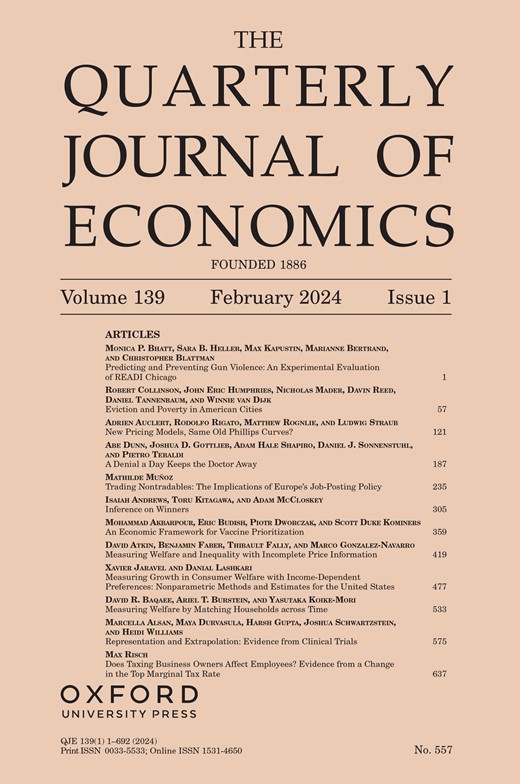失业的地理分布
IF 12.7
1区 经济学
Q1 ECONOMICS
引用次数: 3
摘要
各地劳动力市场的失业率差异很大。我提供了新的经验证据,表明当地高失业率的出现是由于当地失业率的上升。工作稳定性的空间差距主要是由当地雇主造成的,而不是由当地工人或特定地点因素造成的。我提出了一个理论,在这个理论中,由于当地劳动力市场上雇主之间的系统性差异,失业的空间差异以均衡的方式出现。雇主的空间分类决策反过来塑造了不同地点的异质性。劳动力市场的摩擦导致生产性雇主高估彼此靠近的位置。最优政策激励他们迁往失业率高的地区,为常用的基于地方的政策提供了理由。我使用法国的行政数据来估计模型。估计的模型解释了失业率横截面分布的四分之三以上,以及失业和找到工作率各自的贡献。雇主低效的地点选择将空间失业差异放大了5倍。现实世界和最优的基于地方的政策都可以产生可观的地方和总体福利收益。本文章由计算机程序翻译,如有差异,请以英文原文为准。
The Geography of Unemployment
Abstract Unemployment rates differ widely across local labor markets. I offer new empirical evidence that high local unemployment emerges because of elevated local job-losing rates. Local employers, rather than local workers or location-specific factors, account for most of the spatial gaps in job stability. I propose a theory in which spatial differences in job loss emerge in equilibrium because of systematic differences between employers across local labor markets. The spatial sorting decisions of employers in turn shape heterogeneity across locations. Labor market frictions induce productive employers to overvalue locating close to each other. The optimal policy incentivizes them to relocate toward areas with high job-losing rates, providing a rationale for commonly used place-based policies. I estimate the model using French administrative data. The estimated model accounts for over three-quarters of the cross-sectional dispersion in unemployment rates and for the respective contributions of job-losing and job-finding rates. Inefficient location choices by employers amplify spatial unemployment differentials fivefold. Both real-world and optimal place-based policies can yield sizable local and aggregate welfare gains.
求助全文
通过发布文献求助,成功后即可免费获取论文全文。
去求助
来源期刊

Quarterly Journal of Economics
ECONOMICS-
CiteScore
24.20
自引率
2.20%
发文量
42
期刊介绍:
The Quarterly Journal of Economics stands as the oldest professional journal of economics in the English language. Published under the editorial guidance of Harvard University's Department of Economics, it comprehensively covers all aspects of the field. Esteemed by professional and academic economists as well as students worldwide, QJE holds unparalleled value in the economic discourse.
 求助内容:
求助内容: 应助结果提醒方式:
应助结果提醒方式:


